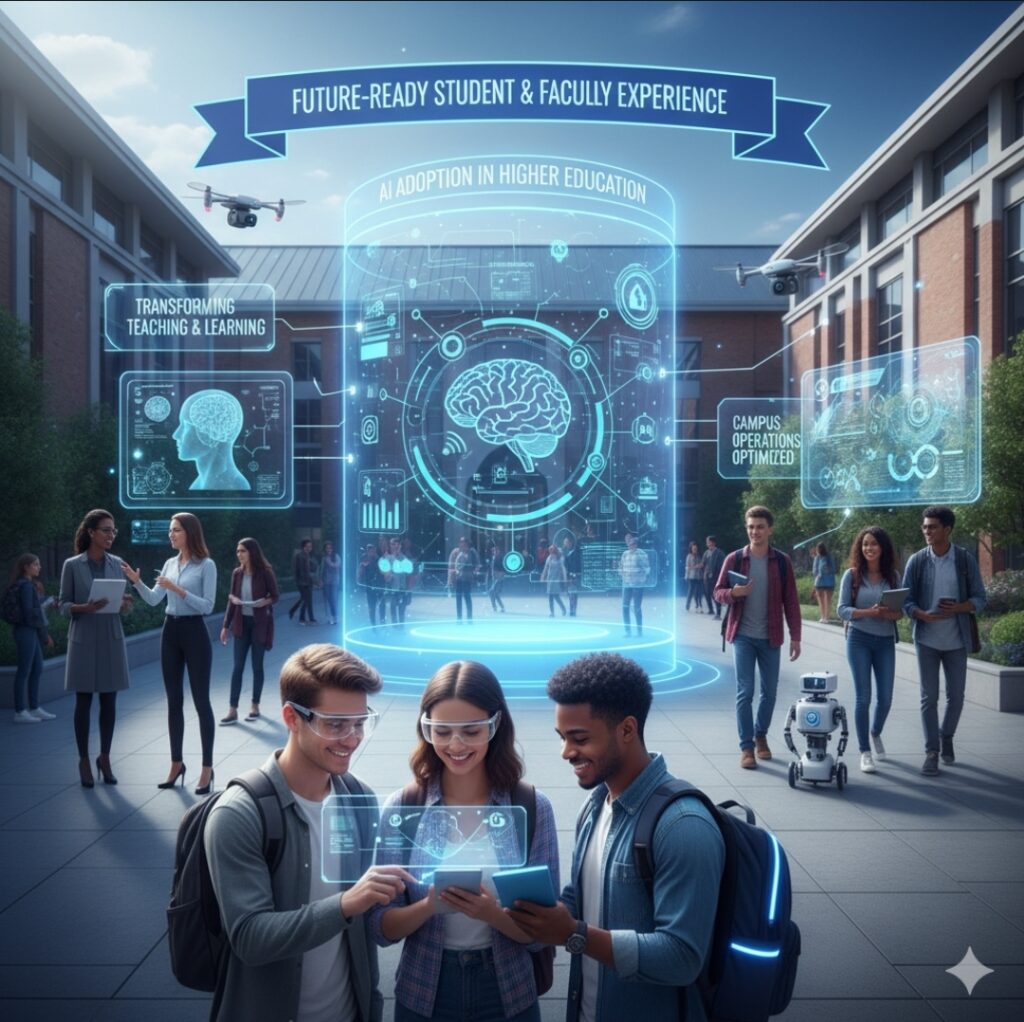The AI Campus Revolution: How Higher Education is Transforming Student and Faculty Experiences
Picture this: A student struggling with complex calculus concepts late one evening receives personalized tutoring recommendations instantly, while across campus, a professor uses generative AI to create adaptive learning materials tailored to each student’s comprehension level. This isn’t science fiction—it’s the current reality reshaping India’s higher education landscape.
The transformation is already underway. According to a comprehensive EY-Parthenon and FICCI report released in October 2025, over 60% of Indian higher education institutions now permit student use of AI tools, marking a seismic shift from experimental adoption to strategic integration. This evolution mirrors a broader global movement where universities are discovering that AI isn’t just about automation—it’s about fundamentally reimagining how education happens.
The Current State of AI Adoption in Indian Universities
Indian higher education institutions are embracing AI at an unprecedented pace. The data reveals compelling adoption patterns that extend far beyond basic experimentation.
Widespread Implementation Across Core Functions
Over half of surveyed institutions now use generative AI to develop learning materials, while 40% deploy AI-powered tutoring systems and chatbots for student support. This represents a significant evolution from traditional one-size-fits-all educational approaches to personalized, adaptive learning experiences that respond to individual student needs.
The scope of AI implementation spans critical academic functions. Approximately 39% of institutions have introduced adaptive learning platforms, and 38% leverage AI for automated grading. These applications demonstrate how AI is reshaping fundamental aspects of education—from curriculum design and assessment models to classroom engagement strategies.
Strategic Priority Alignment
What makes this adoption particularly significant is its strategic nature. Around 60% of institutions have identified AI as a strategic priority and allocated dedicated resources toward it. This isn’t merely about following technology trends; it represents a conscious commitment to educational transformation that positions these institutions for future competitiveness.
The strategic approach is further evidenced by policy development. Over 56% of Indian higher education institutions have already implemented AI-related policies. This governance foundation suggests institutions understand that successful AI integration requires structured frameworks rather than ad hoc implementation.
Beyond the Hype: Real-World Applications Driving Change
The transformation extends beyond impressive statistics to tangible applications that directly impact student experiences and learning outcomes.
Personalized Learning at Scale
AI-powered platforms now analyze student behavior patterns to create individualized learning pathways. These systems evaluate student strengths, weaknesses, and career aspirations to recommend specific courses, projects, and internships. This level of personalization was previously impossible to achieve at scale, but AI makes it accessible to thousands of students simultaneously.
Intelligent Campus Operations
Universities are deploying AI for comprehensive campus management, from energy optimization to predictive maintenance. Smart campus initiatives use IoT sensors and AI analytics to monitor space utilization, reduce energy consumption, and predict equipment failures before they disrupt learning environments.
Advanced systems analyze real-time sensor data to identify energy consumption patterns and suggest efficiency improvements. These applications demonstrate how AI enhances both educational experiences and operational sustainability—a dual benefit that justifies significant technology investments.
Enhanced Research Capabilities
AI is transforming research methodologies across disciplines. Machine learning algorithms help researchers conduct better data assessments and mathematical computations, while AI systems identify academic patterns and generate insights that would be impossible to discover manually.
The Faculty Experience: From Skepticism to Strategic Partnership
Faculty adoption represents one of the most critical success factors in educational AI transformation. The evidence suggests a significant shift in faculty attitudes and capabilities.
Overcoming Initial Resistance
Early faculty concerns about AI replacing human expertise have evolved into recognition of AI as an augmentation tool. Training programs specifically designed for educators now focus on integrating AI tools into teaching practices while maintaining academic integrity and pedagogical quality.
Comprehensive faculty development initiatives help educators understand AI fundamentals, evaluate AI tool applications critically, and develop AI-informed assignments and assessment strategies. These programs emphasize that AI enhances rather than replaces human expertise in education.
Practical Integration Strategies
Faculty members are discovering practical applications that save time while improving educational quality. AI assists in generating lesson plans, creating quiz questions, analyzing large datasets for research, and providing personalized student feedback at scale.
Smart content creation tools help instructors develop digital lessons and study materials more efficiently. This automation of routine tasks enables faculty to focus on higher-value activities—mentoring students, conducting research, and developing innovative pedagogical approaches.
Maintaining Academic Integrity
Successful faculty AI adoption requires balancing innovation with academic integrity. Universities are developing clear policies and guidelines that define appropriate AI use in teaching, research, and assessment while maintaining educational standards and ethical considerations.
Student Experience Transformation: From Passive to Active Learning
AI implementation is fundamentally altering how students engage with educational content and support systems.
24/7 Intelligent Support
AI-powered chatbots and virtual assistants provide round-the-clock student support. These systems handle routine questions, provide instant answers based on course materials, and guide students through administrative processes. This availability addresses one of higher education’s persistent challenges—providing timely support when students need it most.
Adaptive Learning Experiences
AI enables truly personalized education by adapting to individual learning styles and pacing. Students receive customized learning recommendations, targeted skill development suggestions, and real-time feedback that helps them understand complex concepts more effectively.
Advanced tutoring platforms use AI to create interactive learning experiences that adjust difficulty levels based on student responses. This adaptive approach ensures students are appropriately challenged without becoming overwhelmed—a balance that traditional classroom settings often struggle to achieve.
Enhanced Accessibility and Inclusion
AI technologies make education more accessible to diverse learners with different linguistic backgrounds, learning abilities, and accessibility needs. Language translation tools, voice recognition systems, and alternative content formats ensure that educational opportunities reach broader student populations.
Implementation Challenges: Navigating the Complexity
Despite significant progress, universities face substantial implementation challenges that require strategic attention.
Uneven Progress Across Enablers
While AI adoption shows impressive growth, progress across critical enablers remains uneven. Technology capabilities, faculty readiness, and governance frameworks are developing at different rates, creating potential implementation gaps.
Without deliberate attention to foundational areas, institutions risk fragmented adoption and unregulated use that could undermine learning outcomes and academic integrity. This challenge emphasizes the importance of comprehensive planning rather than piecemeal technology deployment.
Resource and Infrastructure Requirements
Successful AI implementation requires significant investments in digital infrastructure, faculty training, and ongoing technical support. Universities must balance these costs against expected educational and operational benefits while ensuring equitable access across different geographic locations and student populations.
Ethical and Privacy Considerations
AI adoption raises complex ethical questions about data privacy, algorithmic bias, and student autonomy. Universities must develop comprehensive policies that protect student privacy while enabling beneficial AI applications. This requires ongoing dialogue between technology teams, faculty, and students to ensure AI implementation aligns with educational values and ethical standards.
Strategic Framework for Sustainable AI Integration
Successful AI adoption requires systematic approaches that address both immediate opportunities and long-term sustainability.
Phased Implementation Strategy
The most successful institutions adopt phased approaches that begin with pilot programs and scale based on proven results. This methodology allows universities to test assumptions, validate technology choices, and build organizational confidence before making substantial commitments.
Early phases focus on high-impact, low-risk applications such as automated grading and student support chatbots. Later phases tackle more complex applications like predictive analytics and comprehensive learning personalization.
Collaborative Ecosystem Development
AI transformation requires partnerships between universities, technology providers, and industry partners. These collaborations enable resource sharing, expertise development, and innovation acceleration that individual institutions couldn’t achieve independently.
Strategic partnerships also support research commercialization and digital transformation initiatives that benefit entire educational ecosystems rather than isolated institutions.
Continuous Improvement and Adaptation
AI technology evolves rapidly, requiring universities to maintain flexible, adaptive approaches to implementation. Successful institutions establish feedback loops that enable continuous optimization based on student outcomes, faculty experiences, and technology performance.
The Road Ahead: Building AI-Ready Educational Ecosystems
The future of Indian higher education increasingly depends on institutions’ ability to create comprehensive AI-enabled learning environments.
Infrastructure Investment Priorities
Universities must invest in robust digital infrastructure that supports AI applications while ensuring reliable, equitable access. This includes high-speed networking, cloud computing capabilities, and cybersecurity systems that protect sensitive educational data.
Faculty Development as Strategic Priority
Long-term success requires sustained investment in faculty development programs that build AI literacy and pedagogical innovation capabilities. These programs must evolve continuously to keep pace with technological advances and changing educational needs.
Student-Centered Design Principles
All AI implementations should prioritize student learning outcomes and experiences over technological sophistication. This student-centric approach ensures that AI serves educational goals rather than becoming an end in itself.

Key Takeaways for CX and EX Professionals
The higher education AI transformation offers valuable lessons for customer and employee experience professionals across industries:
Personalization at Scale: AI enables mass customization of experiences that were previously impossible to deliver efficiently. Higher education’s success with personalized learning pathways demonstrates how AI can create individually relevant experiences without sacrificing operational efficiency.
Change Management Strategy: Successful AI adoption requires addressing both technical capabilities and human readiness. The faculty development programs emerging in higher education provide models for preparing teams to embrace AI as an augmentation tool rather than a replacement threat.
Governance Framework Development: Clear policies and ethical guidelines are essential for successful AI implementation. Higher education institutions’ policy development processes offer frameworks that other industries can adapt for their specific needs.
Stakeholder Engagement: Involving all stakeholders—students, faculty, administrators—in AI planning and implementation ensures solutions address real needs rather than perceived opportunities. This collaborative approach increases adoption rates and long-term success.
The AI revolution in higher education demonstrates that successful digital transformation isn’t just about technology deployment—it’s about reimagining experiences, relationships, and outcomes in ways that create genuine value for all stakeholders. As other industries grapple with similar AI integration challenges, the lessons emerging from India’s educational transformation provide actionable insights for creating more intelligent, responsive, and human-centered experiences.

